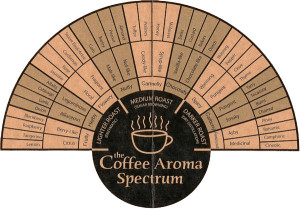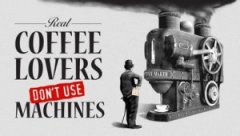Coffee technology teaches you how to distinguish the aroma characteristics of coffee.
During the evaluation of the feeling of coffee, the smell of coffee and our sense of smell are the most important. It's easy to explain. The aroma of coffee is made up of tens of millions of molecules, and these molecules interact to form a sensory map. For tasting, this provides a lot of important information: about the origin of coffee beans that make blended coffee, about the technology of coffee makers. Our sense of smell is very complex, and the mucous membrane of about 2 square centimeters is filled with sensory nerves, which can recognize different molecules and transmit this information to the brain. If there is a weakness, it is that our brains pay less and less attention to the signals sent by our olfactory organs. Our ability to extract olfactory information is not as good as that of visual images.
We can easily extract an image, but we may not be able to extract smell information. For example, when you hear a person's name, you will imagine his appearance and describe him in detail, but only when there is a similar scent of a flower at the scene can we remember the scent of the flower. Only through constant training can we store this olfactory information, but the key does not lie in ourselves. Fragrance features are not only difficult to identify, but also difficult to communicate. In other words, the most important part of our sensory analysis is difficult to measure objectively. When it comes to coffee, this is even more difficult: more than 1000 molecules can arouse our olfactory response, first naturally synthesized by plants and then by multiple programs before final baking. Each molecule carries a message, and when combined with other information, it produces something completely different. If 26 letters allow us to write countless poems and 7 notes allow us to write countless movements, how many emotions can 1000 active molecules carry? Olfactory organs are the only organs that need to work twice: first the act of smelling directly, then the olfactory aftertaste or experience of coffee after drinking or swallowing it. What's the difference?
In the first case, because of the high temperature, the molecules are more volatile, reaching the mucous glands of the cavernous body of the nasal cavity. By dissolving in mucus, they stimulate the receptors. The common aroma of each kind of coffee is the roasting flavor, and only after the entrance can we distinguish the characteristics of good coffee and the professionalism of the maker. After drinking a sip of coffee, its temperature gradually becomes the same as our body temperature. In that case, we would think that our intuition about the aroma of coffee will diminish, but two phenomena change that guess. First of all, the fat in the coffee prolongs the process, which allows the taster to taste it carefully. All this is possible because the aroma components of coffee reach the olfactory mucosa from the back of the throat.
When we smell coffee directly, we can evaluate the intensity and concentration of coffee aroma, roasting intensity and fineness. We can judge good smells and bad smells by the back of the throat. The unpleasant smell is caused by defects in raw coffee, improper roasting or final improper brewing. The good smell is the feeling we can perceive, thanks to the good quality of coffee beans and the good skills of all operators in the production chain. There is also a strong personal evaluation, which can be described as the good feelings brought by a good espresso!

Important Notice :
前街咖啡 FrontStreet Coffee has moved to new addredd:
FrontStreet Coffee Address: 315,Donghua East Road,GuangZhou
Tel:020 38364473
- Prev

The working principle and usage of the Belgian pot for coffee utensils
There are many factors that affect a cup of coffee, how to control them and find the best way to cook them. The following is a list of several variables that can be used as a reference. If you are interested, you can try it yourself. The relationship between the righting time of the upper pot and the temperature of the upper pot, the influence of the time of pouring powder on the extracted coffee juice, the way and times of stirring, the change of powder layer, and the flame.
- Next

Coffee roasting talk about the power of coffee roasting
World-famous coffee enterprises regard strong coffee roasting technology as the key to their development, and many coffee people regard mastering professional coffee roasting technology as the only way for their own development.
Related
- Beginners will see the "Coffee pull flower" guide!
- What is the difference between ice blog purified milk and ordinary milk coffee?
- Why is the Philippines the largest producer of crops in Liberia?
- For coffee extraction, should the fine powder be retained?
- How does extracted espresso fill pressed powder? How much strength does it take to press the powder?
- How to make jasmine cold extract coffee? Is the jasmine + latte good?
- Will this little toy really make the coffee taste better? How does Lily Drip affect coffee extraction?
- Will the action of slapping the filter cup also affect coffee extraction?
- What's the difference between powder-to-water ratio and powder-to-liquid ratio?
- What is the Ethiopian local species? What does it have to do with Heirloom native species?

